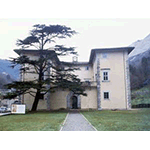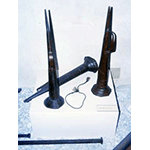Palazzo Mediceo di Seravezza - Museo del Lavoro e delle Tradizioni Popolari della Versilia Storica [Palazzo Mediceo di Seravezza - Museum of Work and Folk Traditions in Historical Versilia]
The Palazzo Mediceo di Seravezza is a site that recalls many themes tied to technology. On order of Cosimo I de’ Medici, it was built between 1560 and 1564 by Bartolomeo Ammannati or, as recently argued for the resemblance of several architectural elements with the Villa of Artimino, by a young Bernardo Buontalenti. The building was erected in an area particularly important for extracting minerals and quarrying marble from Monte Altissimo. The sovereign was thus able to have a close-up picture of the extracting activity which he himself had relaunched. On many occasions, the palazzo hosted the grand duke and duchess who loved to spend summers here. Peter Leopold of Lorraine reserved part of the rooms for the warehouses and administrative offices of an ironworks, still visible beside the palazzo, and built around 1786 along the torrent Ruosina. In 1835, on closing the ironworks, the villa returned to be a holiday spot for the grand-ducal family. With the Unification of Italy, it was transferred to the State, which in 1864 gave it to the Commune of Seravezza. Today, after serving first as a penitentiary and then as Town Hall, the building hosts various cultural organisations including, on the second floor, the Museum of Work and Folk Traditions in Historical Versilia.
Open to the public as of 1996, the Museum was instituted by the Town Council of Seravezza in 1980 to trace back and illustrate the production activities of the area and their historical evolution. A particularly important source, thanks to the quarries of Monte Altissimo, the marble industry is documented with a series of utensils, machines and machine models that illustrate the techniques of quarrying, transporting and milling, practised in the area. The exhibition of several tools utilised in ironworks and craftsmen’s workshops also illustrates two other important activities of Medici Versilia: mining, which has an ancient origin, and ironworking. Finally, objects tied to domestic activities are also exhibited, such as weaving and various kinds of farming equipment, used both in the mountains and on the plains. The collection is accompanied by an abundance of photographs and cards illustrating the function of the various objects on show. The work tools can be dated from the late 18th century to the mid 20th century.
****************************
Texts by Graziano Magrini
English translation by Victor Beard
Last update 31/gen/2008





